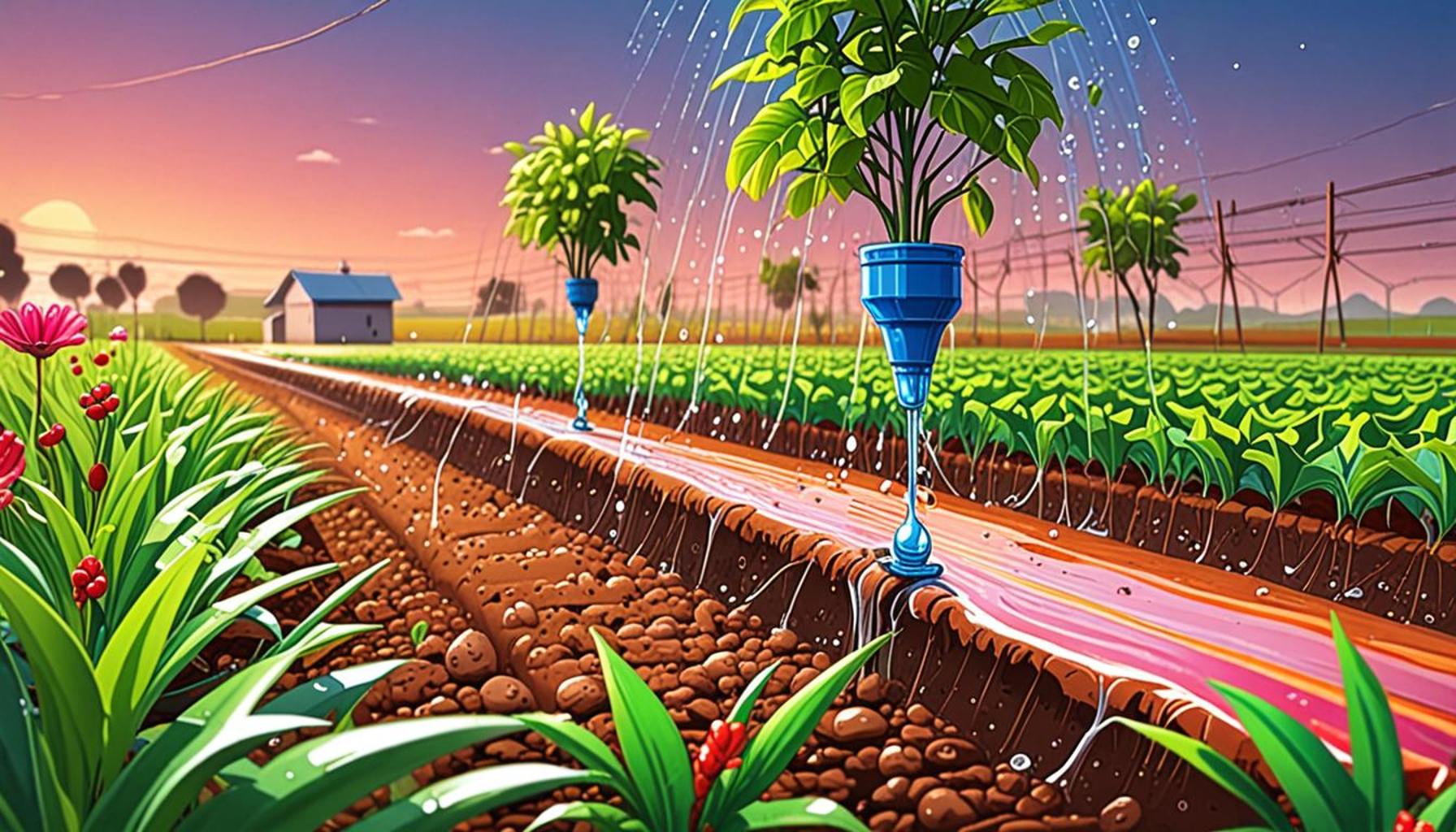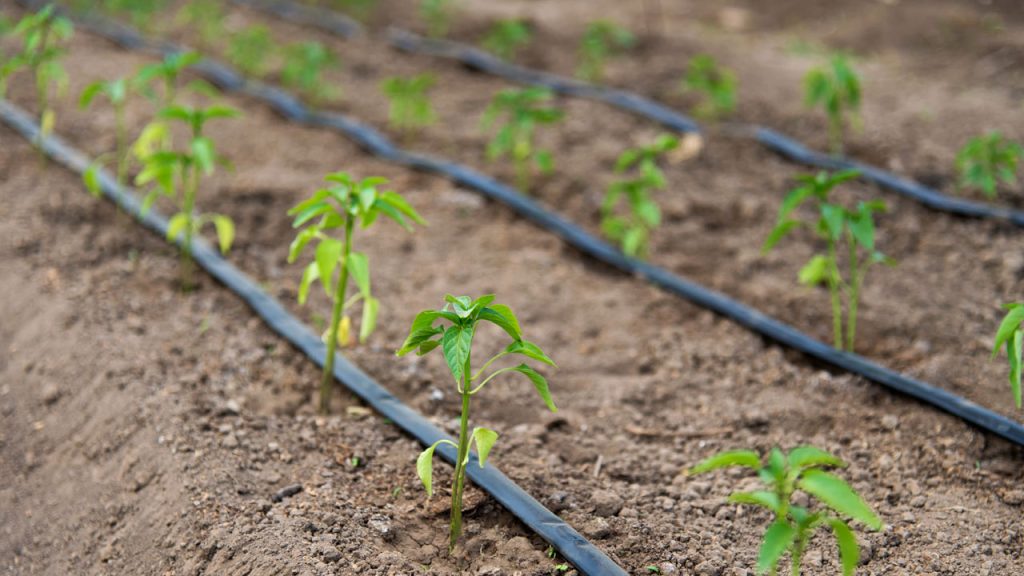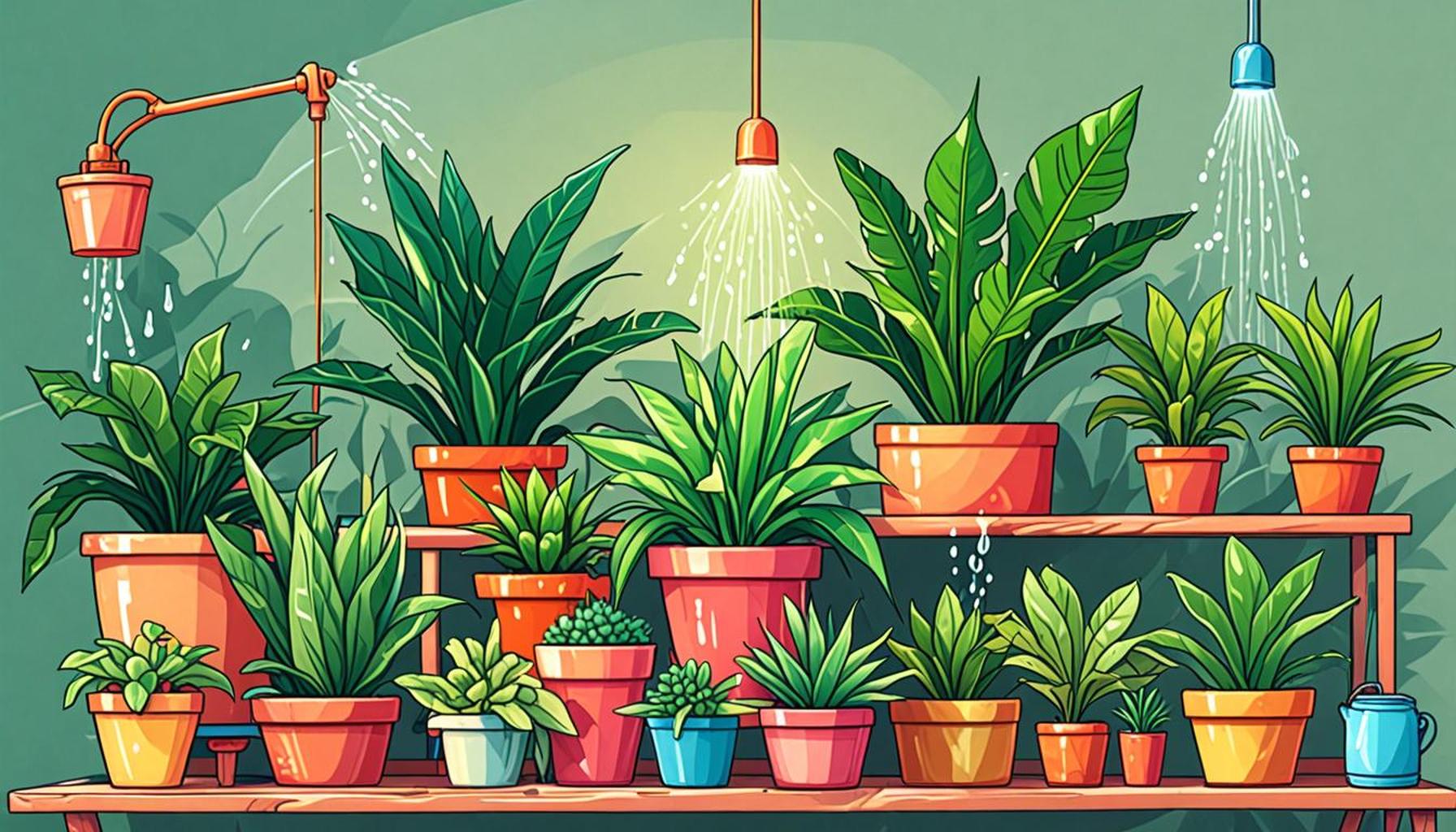Drip Irrigation Techniques: Saving Water and Nutrients

Understanding the Importance of Drip Irrigation
Water is an essential resource for agriculture, yet increasing climate variability and population growth are straining this precious supply, particularly in the arid regions of the American Southwest. In states like California, Arizona, and Nevada, farmers are facing unprecedented challenges, making innovative solutions vital for effective crop cultivation. One of the most promising methods to address water scarcity is the adoption of drip irrigation techniques.
How Drip Irrigation Works
Unlike traditional irrigation methods such as flood or overhead sprinkler systems, which often lead to significant water loss through evaporation or runoff, drip irrigation delivers water directly to the roots of plants through a network of tubing and emitters. This technology allows precise control over water application, ensuring that each plant receives the optimal amount of moisture it requires for healthy growth.
Benefits of Drip Irrigation
- Efficient Water Use: Drip irrigation systems can use up to 60% less water compared to conventional irrigation methods. This remarkable efficiency is particularly beneficial in drought-prone areas, reducing the overall demand for water.
- Improved Nutrient Delivery: By allowing fertilizers to be mixed with the water supplied to the plants, drip systems ensure that essential nutrients are delivered directly to the root zone, promoting better nutrient uptake and plant health.
- Reduced Weed Growth: Since water is applied only to the areas where crops are planted, moisture is limited in unplanted regions, thereby suppressing weed growth and reducing the need for herbicides.
The Economic Impact
Incorporating drip irrigation doesn’t just conserve water; it also enhances crop yield and quality. Research has demonstrated that farmers can boost their production by up to 40% when transitioning from overhead irrigation to drip systems. This increase not only supports the farmer’s bottom line but also contributes to greater food security.
Real-World Applications
Numerous farms across the United States have successfully integrated drip irrigation into their practices. For example, tomato growers in California, who often encounter water restrictions, have reported surges in crop quality and quantity after switching to this method. Similarly, vineyard operators in the Napa Valley have embraced drip irrigation technology, leading to superior grape quality, which is crucial for wine production.
Moving Towards Sustainability
As we explore the avenues for adopting drip irrigation, it’s clear that this practice holds significant potential for sustainable agriculture. With water scarcity becoming a more pressing issue, incorporating techniques like these could be the key to a sustainable agricultural future. Whether you are a large-scale farmer or a home gardener, understanding and implementing drip irrigation can lead to outstanding results in water conservation and crop efficiency.

Consider investigating local resources and agricultural extension services that can provide guidance on implementing drip irrigation in your farming or gardening practices. The journey towards sustainable water use starts with informed decisions and innovative technologies.
DISCOVER MORE: Click here for the ultimate guide to choosing plants
Exploring the Mechanics of Drip Irrigation
To truly appreciate the transformative power of drip irrigation techniques, it is essential to delve into the mechanics that make this system a revolution in water management. Drip irrigation systems are composed of various elements, including a mainline, submains, lateral lines, and emitters. The water source is routed through this network, with emitters strategically placed along the lateral lines to release water slowly and directly into the soil surrounding the plant roots. This targeted delivery is crucial for conserving both water and nutrients, as it reduces evaporation and runoff significantly.
The Components of a Drip Irrigation System
Understanding the components involved in drip irrigation helps in grasping why it is such an effective method for resource conservation. Key components include:
- Water Source: This can be a well, municipal supply, or rainwater collection system. The source is essential for determining the efficiency of the irrigation system.
- Filtration System: To prevent clogging, drip systems often incorporate filters that remove debris and sediment from the water before it reaches the emitters.
- Pipes and Tubing: Flexible tubing carries water from the supply to the plants. The flexibility allows it to be laid out in various configurations to meet different agricultural needs.
- Emitters: These are the heart of the system, releasing water at a specified rate to ensure plants get just the right amount of moisture. Emitters can be designed for different flow rates and can accommodate various planting layouts.
- Pressure Regulator: Maintaining a consistent water pressure is vital for optimal performance, preventing damage to emitters and ensuring uniform watering across the field.
Implementing Drip Irrigation
Transitioning to a drip irrigation system involves careful planning and consideration. Factors such as the type of crops being cultivated, soil characteristics, and climatic conditions play a vital role in system design. Farmers must evaluate their specific needs and potential barriers. Depending on the scale, both low-pressure and high-pressure systems are available, allowing adaptability to different farming operations.
Furthermore, the ability to integrate drip irrigation with advanced technologies, such as soil moisture sensors and weather tracking systems, has enhanced its effectiveness. By leveraging data, farmers can fine-tune their irrigation schedules, ensuring that water is delivered when it is most needed and in precise amounts. This reduces waste and further promotes nutrient retention in the soil.
A Broader Perspective: Drip Irrigation in Action
The impact of adopting drip irrigation can be seen across a variety of crops and regions. From row crops like corn and soybeans to high-value specialty crops such as strawberries and avocados, farmers who have embraced this technology report higher yields, improved quality, and reduced production costs. Additionally, organizations and agribusinesses are increasingly sponsoring workshops and providing financial assistance to help farmers make the shift towards this efficient system.
As we explore further, the successes of implementing drip irrigation not only highlight its practicality but also shine a light on the larger picture of sustainable agriculture. The transition is more than just a series of technical adjustments; it marks a pivotal step toward a future where water and nutrient management become increasingly sustainable and resilient in the face of climate challenges.
| Category | Advantages |
|---|---|
| Water Conservation | Drip irrigation techniques deliver water directly to the roots of plants, significantly reducing evaporation and runoff. |
| Nutrient Efficiency | By applying nutrients through the drip system, plants can absorb them more effectively, minimizing waste and enhancing growth. |
President of the Water Conservation Alliance states that using drip irrigation can reduce water usage by up to 60% when compared to traditional methods. This system is particularly beneficial in drought-prone areas where every drop counts. As noted by agricultural experts, the precision of drip irrigation not only benefits plants by supplying moisture and nutrients directly to the root zone but also helps mitigate the risk of overwatering, which can lead to root rot and other health issues for plants.Additionally, farmers utilizing drip systems often report increased crop yield due to the optimal conditions created through consistent moisture levels. Furthermore, the technology allows for automation, which can lead to labor savings and reduced carbon footprints, aligning agricultural practices with sustainable goals. The versatility of drip irrigation makes it suitable for a wide variety of crops, from vegetables to orchards, thus offering a holistic approach to modern agriculture that can address both *nutrient management* and *water efficiency*. It is essential to explore the benefits of adopting such innovative techniques, as they promise not only to conserve precious resources but also to elevate the standards of agricultural productivity.
DISCOVER MORE: Click here to learn about capillary irrigation
Maximizing Efficiency: Benefits of Drip Irrigation Techniques
The advantages of drip irrigation techniques extend far beyond initial water savings. A myriad of benefits contributes to its growing popularity among agricultural producers looking to enhance productivity while practicing environmental stewardship. Key benefits associated with implementing drip irrigation include increased efficiency, cost savings, and improved crop yields.
Enhanced Water Efficiency
One of the most significant benefits of drip irrigation is its proven ability to maximize water use efficiency. Traditional flood or sprinkler irrigation methods often lead to significant losses due to evaporation, runoff, and oversaturation. In contrast, drip irrigation delivers water directly to the root zone, reducing evaporation rates by as much as 50% in hot climates. According to the USDA, farms using drip irrigation typically consume 20-50% less water than those utilizing other irrigation practices.
Cost-Effective Nutrient Management
Drip irrigation not only conserves water but also allows for tailored nutrient management. With the capability to apply fertilizers directly through the system—known as fertigation—farmers can streamline their nutrient delivery. This method ensures that plants receive the nutrients they need at critical growth stages, thus optimizing their uptake. Studies have shown that this targeted approach can lead to reductions in fertilizer usage by up to 30%, mitigating the risk of nutrient leaching and promoting better soil health.
Positive Impact on Crop Health
The consistent moisture levels fostered by drip irrigation contribute to improved crop health and resilience. As plants receive regular moisture, they are less prone to stress, leading to higher quality produce and better yields. According to research from the University of California, crops irrigated through drip systems can yield between 10-30% more than those using traditional methods. Moreover, the reduced moisture on foliage can decrease the incidence of fungal diseases, thus minimizing the need for chemical interventions.
Environmental and Economic Advantages
The environmental benefits of adopting drip systems are irrefutable. By conserving water and nutrients, drip irrigation techniques contribute to less strained water resources and improved soil conditions. Additionally, the decrease in runoff helps protect local waterways from pollution, thus supporting broader ecological health. The economic implications are substantial as well; farmers who transition to drip irrigation often report lower operational costs due to reduced water and fertilizer expenses. The initial investment in drip technology can be quickly offset by these savings, along with potential increases in crop revenue.
Real-World Success Stories
Numerous farms across the United States have successfully implemented drip irrigation and reaped the rewards. For instance, the California Central Valley, one of the most productive agricultural regions globally, has seen a notable increase in the adoption of drip systems among growers of almonds, grapes, and citrus. Reports indicate that almond farmers using drip irrigation have improved water management while achieving yields in line with the crop’s growth potential.
Moreover, organizations such as the National Resources Conservation Service (NRCS) are providing funding and technical assistance to facilitate the transition towards drip irrigation on both small and large farms. Beyond financial incentives, these programs are increasing awareness about the long-term sustainability benefits that come with adopting such advanced irrigation systems.
As the agricultural landscape evolves to address ongoing challenges such as water scarcity and climate variability, drip irrigation techniques stand as a beacon of innovation. Farmers who are willing to adapt and embrace these methods may find themselves at the forefront of a more sustainable and profitable agricultural future.
DIVE DEEPER: Click here to discover effective pest control strategies
Conclusion: Embracing Drip Irrigation for a Sustainable Future
In summary, drip irrigation techniques represent a crucial advancement in agricultural practices aimed at conserving vital resources while enhancing productivity. The significant reductions in water usage—averaging 20-50%—along with optimized nutrient management through methods such as fertigation, underscore the transformative potential of this irrigation strategy. Farmers can reap not only the environmental rewards of diminished runoff and healthier soil but also economic benefits stemming from lower operational costs and improved crop yields.
As demonstrated in agricultural success stories across the United States, including the California Central Valley, the shift towards drip irrigation is already yielding tangible results. Here, farmers witness increased resilience in crops, which contributes to higher quality and greater quantities of produce. With the backing of organizations like the National Resources Conservation Service (NRCS), resources are becoming more accessible, empowering farmers to make this vital transition.
Looking ahead, as climate challenges and water scarcity intensify, the necessity of adapting efficient irrigation methods like drip systems will only become more pronounced. It’s an opportunity for growers to redefine their practices, positioning themselves as champions of sustainability in the agricultural sector. As the conversation around water conservation and nutrient management continues to evolve, drip irrigation techniques will undoubtedly be at the forefront, paving the way for a more sustainable and prosperous future in farming. This is not just about saving water and nutrients; it is about nurturing the future of agriculture.


